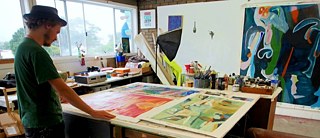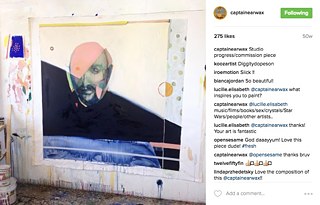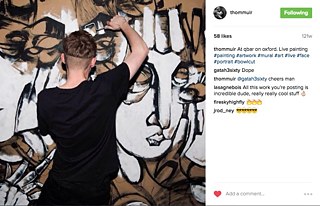Art and Social Media
The artists of Instagram

Instagram, the widely popular image based social media platform, known for its celebrity selfies, food bloggers and ‘insta-famous’ brand promoters is also being used by artists around the world to great success. The site is launching careers, keeping artists relevant, and changing the way audiences engage with the art world.
Since its introduction in 2010, Instagram, with its hyper-engaged audience and image centric layout, has become a social media staple. For artists the platform offers another possibility: journaling their work online and marketing themselves to the world. Many of them, both under the radar and established, are using it to their benefit and in a lot of cases Instagram has become essential to their careers.
WHY DO ARTISTS LOVE INSTAGRAM?
Daniel O’Toole (or EARS) has been working as a professional artist since 2008. Initially, he had to be convinced to join Instagram by a friend. “It had been around for a few years before I got onto it and I remember not getting it and not wanting to be a part of it at first, feeling like it was a bit of a flash in the pan trend.”Four years later, O’Toole has 8332 followers on his account ‘captainearwax’, and says Instagram has become essential. “I would say that 80 to 90 percent of the emails I get through my website have found out about my work through Instagram. I always ask them how they got onto my website and they always say Instagram.”
O’Toole thinks a big reason for this is the engaged nature of users. “It’s like a virtual gallery space. It’s a way of exhibiting your work to a pretty big audience that are connecting. That is the main thing about Instagram. It always seemed to have had a very engaged audience. People are very diligently checking their ‘Insta’, they’re kind of addicted to it.”
A NEW GENERATION OF ART CONSUMERS
O’ Toole is correct with his assumption. According to Brandwatch, as of May 2016 Instagram had 400 million active users. Of that number 90 percent are under the age of 35, and 60 percent are logging in daily. This makes Instagram the second most engaged network after Facebook. Pair this with a stream of artists who are posting their work daily and one gets a generation of youth who are engaging with the art world in ways that have never been seen before. The established art culture is shifting, and the importance of agents and galleries is slowly diminishing.
With Instagram, artists are able to market their own work and sell directly to their followers. In fact, Instagram has proven to be an amazing marketing tool for all types of brands. According to a study by Locowise, 50 percent of Instagram users follow at least one business, with 75 percent of them taking action when they see a product post, such as visiting a website.
Now that artists are marketing themselves, galleries, agents and other middlemen are losing their relevance. By creating their own personal brands and selling directly to their followers, artists have more power and less concern about giving away a cut of their profit.
Up and coming multi-disciplinary artist Thom Muir calls Instagram an amazing marketing tool. “Many of the artists I know only get sales and commissions from their Instagram accounts. It’s great for marketing as artists no longer need to receive a lot of press to gain a following.”
A PERSONAL CONNECTION
With this elimination of the middleman, audiences are getting closer to artists than ever before. Personality and progress are becoming almost as important as the work itself. Instagram accounts are peppered with progress shots and descriptions of the process and materials used, with followers often asking questions about the work. Artists are aware of this, and are making sure to include personal elements on their accounts. Muir believes that this is the key to becoming hugely successful on Instagram. “The artists who are really popular on Instagram are creating a cult of personality. They have a signature style art-wise and promote that in conjunction with their personal lives.”
One thing is certain: the established ideas of how artists market and exhibit their work are changing. The art world is moving forward on unfamiliar terrain, and with the rapid evolution of new technologies, only time will tell what the future holds.
“I don’t think that Instagram is the future of the art world, but it is the first step in a different direction”, says Muir.